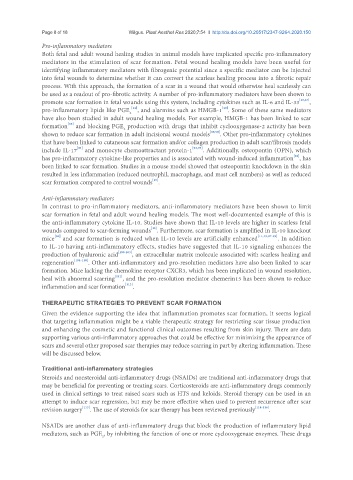Page 629 - Read Online
P. 629
Page 8 of 18 Wilgus. Plast Aesthet Res 2020;7:54 I http://dx.doi.org/10.20517/2347-9264.2020.150
Pro-inflammatory mediators
Both fetal and adult wound healing studies in animal models have implicated specific pro-inflammatory
mediators in the stimulation of scar formation. Fetal wound healing models have been useful for
identifying inflammatory mediators with fibrogenic potential since a specific mediator can be injected
into fetal wounds to determine whether it can convert the scarless healing process into a fibrotic repair
process. With this approach, the formation of a scar in a wound that would otherwise heal scarlessly can
be used as a readout of pro-fibrotic activity. A number of pro-inflammatory mediators have been shown to
promote scar formation in fetal wounds using this system, including cytokines such as IL-6 and IL-33 [45,47] ,
[48]
pro-inflammatory lipids like PGE 2 [44] , and alarmins such as HMGB-1 . Some of these same mediators
have also been studied in adult wound healing models. For example, HMGB-1 has been linked to scar
[88]
formation and blocking PGE production with drugs that inhibit cyclooxygenase-2 activity has been
2
shown to reduce scar formation in adult incisional wound models [89,90] . Other pro-inflammatory cytokines
that have been linked to cutaneous scar formation and/or collagen production in adult scar/fibrosis models
[91]
include IL-17 and monocyte chemoattractant protein-1 [92,93] . Additionally, osteopontin (OPN), which
[94]
has pro-inflammatory cytokine-like properties and is associated with wound-induced inflammation , has
been linked to scar formation. Studies in a mouse model showed that osteopontin knockdown in the skin
resulted in less inflammation (reduced neutrophil, macrophage, and mast cell numbers) as well as reduced
[95]
scar formation compared to control wounds .
Anti-inflammatory mediators
In contrast to pro-inflammatory mediators, anti-inflammatory mediators have been shown to limit
scar formation in fetal and adult wound healing models. The most well-documented example of this is
the anti-inflammatory cytokine IL-10. Studies have shown that IL-10 levels are higher in scarless fetal
wounds compared to scar-forming wounds . Furthermore, scar formation is amplified in IL-10 knockout
[49]
[96]
mice and scar formation is reduced when IL-10 levels are artificially enhanced [11,49,97-99] . In addition
to IL-10 having anti-inflammatory effects, studies have suggested that IL-10 signaling enhances the
production of hyaluronic acid [100-103] , an extracellular matrix molecule associated with scarless healing and
regeneration [104-110] . Other anti-inflammatory and pro-resolution mediators have also been linked to scar
formation. Mice lacking the chemokine receptor CXCR3, which has been implicated in wound resolution,
heal with abnormal scarring [111] , and the pro-resolution mediator chemerin15 has been shown to reduce
inflammation and scar formation [112] .
THERAPEUTIC STRATEGIES TO PREVENT SCAR FORMATION
Given the evidence supporting the idea that inflammation promotes scar formation, it seems logical
that targeting inflammation might be a viable therapeutic strategy for restricting scar tissue production
and enhancing the cosmetic and functional clinical outcomes resulting from skin injury. There are data
supporting various anti-inflammatory approaches that could be effective for minimizing the appearance of
scars and several other proposed scar therapies may reduce scarring in part by altering inflammation. These
will be discussed below.
Traditional anti-inflammatory strategies
Steroids and nonsteroidal anti-inflammatory drugs (NSAIDs) are traditional anti-inflammatory drugs that
may be beneficial for preventing or treating scars. Corticosteroids are anti-inflammatory drugs commonly
used in clinical settings to treat raised scars such as HTS and keloids. Steroid therapy can be used in an
attempt to induce scar regression, but may be more effective when used to prevent recurrence after scar
revision surgery [113] . The use of steroids for scar therapy has been reviewed previously [114-116] .
NSAIDs are another class of anti-inflammatory drugs that block the production of inflammatory lipid
mediators, such as PGE , by inhibiting the function of one or more cyclooxygenase enzymes. These drugs
2

